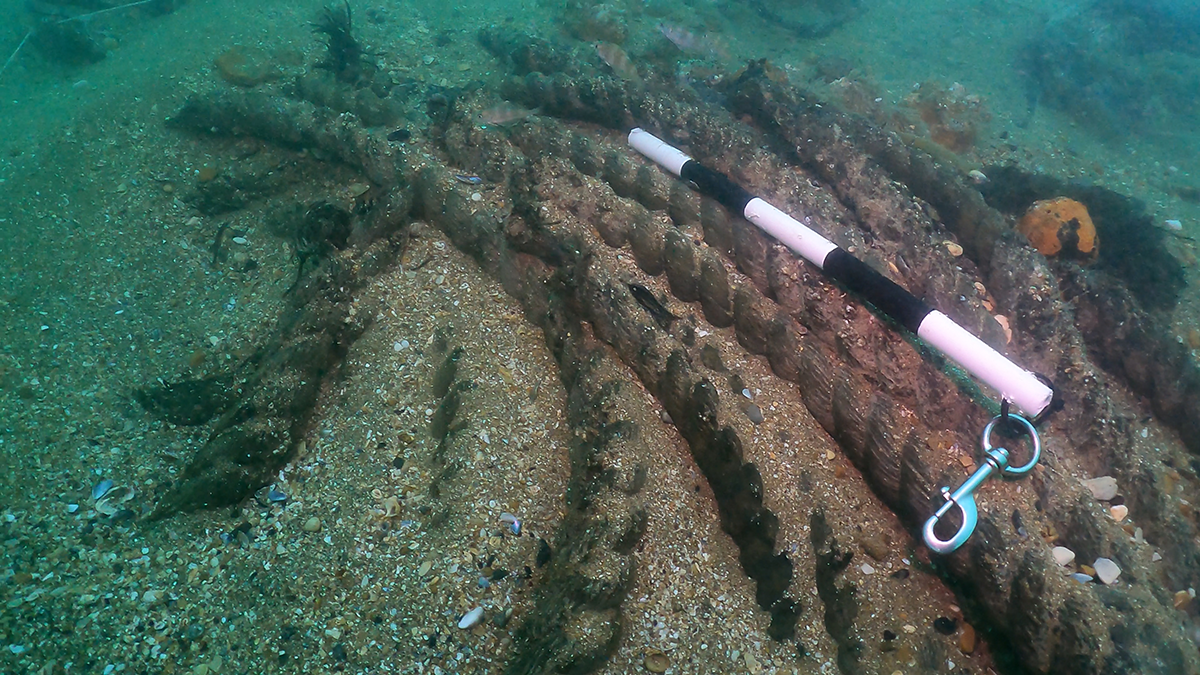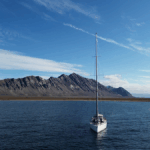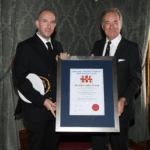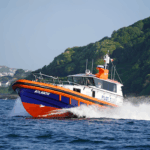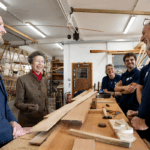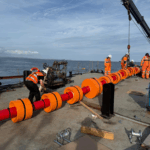New evidence from Historic England to assess the condition of the Protected Wreck Site of the 18th century English warship the Northumberland, reveals that a remarkably large section of the warship may survive intact on the seabed.
The survey, working with the Licensee of the Northumberland wreck, Dan Pascoe, who regularly dives it, and contractors MSDS Marine, showed that organic material such as wooden decks, wooden chests – some including cannon balls and the ship’s rope – have survived particularly well. This is due to being covered by sand and seabed sediments for hundreds of years.
The Northumberland Protected Wreck Site
The Northumberland was a Third Rate 70-gun warship built in Bristol in 1679 as part of Samuel Pepys’ regeneration of the English Navy. It sank during the ‘Great Storm’ on 26 November 1703 on the treacherous Goodwin Sands off the Kent coast, with three other warships the Restoration, and the Stirling Castle and the Mary – the location of which is still to be determined. They were all part of Queen Anne’s fleet, who was the last Stuart monarch, reigning from 1702 to 1714.

Heritage at Risk
Shifting sands, strong currents and wood boring sea creatures, which burrow into and damage wooden structures on the seabed, continue to make this fragile Protected Wreck Site unstable, putting it at high risk of deterioration. It lies over a large area of the seabed between 15-20 metres deep and is covered by concretion or marine deposits, however more of it is being exposed every day.
First designated as a Protected Wreck Site in 1981, the Northumberland has been on Historic England’s Heritage at Risk Register since 2017. Its condition is carefully monitored by Licensee Dan Pascoe, as part of Historic England’s ongoing field work looking after England’s 57 Protected Wreck Sites on behalf of the Department for Culture, Media and Sport (DCMS).
What’s been discovered
The latest survey work by Historic England carried out last summer in partnership with MSDS Marine and Licensee Dan Pascoe reveals:
- Evidence of extensive hull structure on the seabed possibly lying on its port side, including exposed deck planks and the wooden skeleton or frame of the ship – much more than previously thought
- Evidence of multiple wooden decks
- Exceptionally well-preserved organic material such as coils of rope on a timber deck
- Multiple wooden chests – some containing musket balls and one completely sealed with contents unknown
- Seven iron cannons confirmed at the southeast end of the wreck site, alongside another six cannons further north
- Part of a wooden gun carriage, swords and muskets
- Copper cauldrons
The finds remain in situ on the seabed.
Paul Jeffery, Marine Team Leader at Historic England, said: “The completeness of the Northumberland wreck site is remarkable. Historic England’s diving work is so important to ensure we continue to record what we can of this site. It is a race against time as more of the Northumberland wreck becomes exposed.”
Historian Dan Snow, founder of streaming service, History Hit, also visited the Protected Wreck Site and has produced a film about the latest survey work.
Dan Pascoe, Licensee of the Northumberland, said: “The Northumberland has the potential to be one of the best-preserved wooden warships in the UK. However, at 20 metres underwater and 9 miles offshore it is out of sight and mind to most people. Through History Hit the wreck and its many stories will become accessible to a wider audience, allowing the significance of this shared heritage to be fully realised.”
Dan Snow, Founder and Creative Director of History Hit, said: “Northumberland is THE missing link. Built roughly halfway between the Mary Rose and HMS Victory, this wreck can fill in crucial details of shipbuilding and life at sea at that pivotal moment in our history. We have the Mary Rose, the ‘Tudor time capsule’, well here’s a Stuart time capsule to sit alongside it.”
Dan Snow added: “At History Hit, this is at the core of what we do – working with the best experts to bring the biggest stories to a global audience of history super fans. By partnering with leading authorities like Historic England, MSDS Marine and Licensee Dan Pascoe, we ensure that this incredible chapter of history reaches those who are passionate about our shared past.”

Alison James, Heritage and Systems Manager at MSDS Marine said: “The Northumberland has so much potential to tell us more about the English Navy and ships of the period. It’s also a rich resource for local communities to benefit from. Dan Snow and History Hit are helping to bring the site to new audiences.”
Future work on the site may include taking wood samples or dendrochronological sampling to find out more about the ship’s construction and help confirm the ship’s identity.
The History film: ‘Shipwreck Northumberland and the Great Storm’ airs tonight (Thursday, 31 July) to subscribers and will later be more widely available. Dan Snow investigates the ship’s construction, its pivotal role in the English Navy’s search for the perfect warship and the circumstances surrounding its tragic loss.







